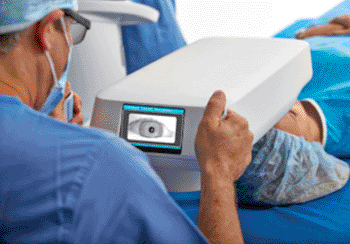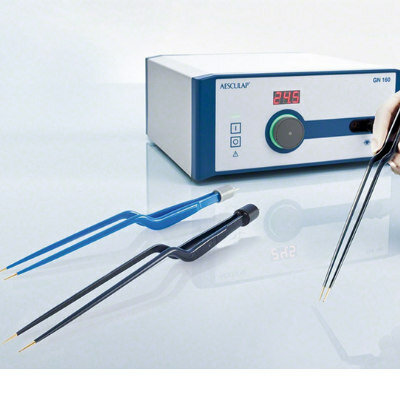Nonsurgical Solution Helps Correct Myopia
|
By HospiMedica International staff writers Posted on 28 Nov 2013 |

Image: The Avedro KXL II System (Photo courtesy of Avedro).
A new system uses accelerated photorefractive intrastromal cross-linking (PiXL) procedures for the treatment of myopia and keratoconus.
The KXL II System uses a combination of long ultraviolet (UVA) light waves and riboflavin (vitamin B2) to form cross-linked chemical bonds within the cornea, increasing its rigidity and stability. During the treatment, a photosensitive preparation of ribolflavin eye drops is applied to the cornea, which is then soaked for approximately 60 seconds. The ribolflavin is then dynamized by the UVA rays, a step that lasts for three minutes, during which the riboflavin penetrates the corneal surface by a few microns and induces the lamellae to move closer together.
The KXL II system achieves higher cross-linking speed by increasing UVA power and reducing the exposure time, thereby maintaining the same energy on the eye as standard cross-linking, while reducing cross-linking time by an order of magnitude. The outpatient procedure is noninvasive and painless, lasting for approximately, five minutes per eye from start to finish, compared to the 30 minutes time span required to carry out a standard cross-linking procedure. Another advantage is that it can be repeated later.
An further important advantage of the KXL II accelerated cross-linking system is that unlike the traditional technique, it does not involve removal of the corneal epithelium—the thinnest layer on the outside of the cornea—before administering riboflavin eye drops and UVA light. This allows thinner corneas to be cross-linked with greater precision, potentially decreasing risks and allowing patients outside current treatment criteria to be cross-linked. The KXL II System is a product of Avedro (Boston, MA, USA), and has received the European community CE marking of approval.
“The KXL II and PiXL procedure continue our mission to make refractive correction truly nonsurgical,” said David Muller, PhD, CEO of Avedro. “Treating myopia and other refractive disorders with PiXL has the potential to open up refractive correction to millions of people who have never considered Lasik surgery before, but would consider a nonsurgical alternative.”
“We experienced the amazing capabilities of customized accelerated cross-linking to achieve specific, reproducible, and interim-stable refractive changes on the cornea,” said A. John Kanellopoulos, MD, of the NYU Medical School (NY, USA). “It seems to me that every surgeon who has performed cross-linking has experienced refractive corneal changes. We now have a way to design and customize these refractive changes. If these initial clinical results continue to be repeated, as I believe they will, the potential seems unlimited.”
Related Links:
Avedro
The KXL II System uses a combination of long ultraviolet (UVA) light waves and riboflavin (vitamin B2) to form cross-linked chemical bonds within the cornea, increasing its rigidity and stability. During the treatment, a photosensitive preparation of ribolflavin eye drops is applied to the cornea, which is then soaked for approximately 60 seconds. The ribolflavin is then dynamized by the UVA rays, a step that lasts for three minutes, during which the riboflavin penetrates the corneal surface by a few microns and induces the lamellae to move closer together.
The KXL II system achieves higher cross-linking speed by increasing UVA power and reducing the exposure time, thereby maintaining the same energy on the eye as standard cross-linking, while reducing cross-linking time by an order of magnitude. The outpatient procedure is noninvasive and painless, lasting for approximately, five minutes per eye from start to finish, compared to the 30 minutes time span required to carry out a standard cross-linking procedure. Another advantage is that it can be repeated later.
An further important advantage of the KXL II accelerated cross-linking system is that unlike the traditional technique, it does not involve removal of the corneal epithelium—the thinnest layer on the outside of the cornea—before administering riboflavin eye drops and UVA light. This allows thinner corneas to be cross-linked with greater precision, potentially decreasing risks and allowing patients outside current treatment criteria to be cross-linked. The KXL II System is a product of Avedro (Boston, MA, USA), and has received the European community CE marking of approval.
“The KXL II and PiXL procedure continue our mission to make refractive correction truly nonsurgical,” said David Muller, PhD, CEO of Avedro. “Treating myopia and other refractive disorders with PiXL has the potential to open up refractive correction to millions of people who have never considered Lasik surgery before, but would consider a nonsurgical alternative.”
“We experienced the amazing capabilities of customized accelerated cross-linking to achieve specific, reproducible, and interim-stable refractive changes on the cornea,” said A. John Kanellopoulos, MD, of the NYU Medical School (NY, USA). “It seems to me that every surgeon who has performed cross-linking has experienced refractive corneal changes. We now have a way to design and customize these refractive changes. If these initial clinical results continue to be repeated, as I believe they will, the potential seems unlimited.”
Related Links:
Avedro
Latest Surgical Techniques News
- Minimally Invasive Endoscopic Surgery Improves Severe Stroke Outcomes
- Novel Glue Prevents Complications After Breast Cancer Surgery
- Breakthrough Brain Implant Enables Safer and More Precise Drug Delivery
- Bioadhesive Sponge Stops Uncontrolled Internal Bleeding During Surgery
- Revolutionary Nano Bone Material to Accelerate Surgery and Healing
- Superior Orthopedic Implants Combat Infections and Quicken Healing After Surgery
- Laser-Based Technique Eliminates Pancreatic Tumors While Protecting Healthy Tissue
- Surgical Treatment of Severe Carotid Artery Stenosis Benefits Blood-Brain Barrier
- Revolutionary Reusable Duodenoscope Introduces 68-Minute Sterilization
- World's First Transcatheter Smart Implant Monitors and Treats Congestion in Heart Failure
- Hybrid Endoscope Marks Breakthrough in Surgical Visualization
- Robot-Assisted Bronchoscope Diagnoses Tiniest and Hardest to Reach Lung Tumors
- Diamond-Titanium Device Paves Way for Smart Implants that Warn of Disease Progression
- 3D Printable Bio-Active Glass Could Serve as Bone Replacement Material
- Spider-Inspired Magnetic Soft Robots to Perform Minimally Invasive GI Tract Procedures
- Micro Imaging Device Paired with Endoscope Spots Cancers at Earlier Stage
Channels
Critical Care
view channel
Light-Based Technology to Measure Brain Blood Flow Could Diagnose Stroke and TBI
Monitoring blood flow in the brain is crucial for diagnosing and treating neurological conditions such as stroke, traumatic brain injury (TBI), and vascular dementia. However, current imaging methods like... Read more
AI Heart Attack Risk Assessment Tool Outperforms Existing Methods
For decades, doctors have relied on standardized scoring systems to assess patients with the most common type of heart attack—non-ST-elevation acute coronary syndrome (NSTE-ACS). The GRACE score, used... Read morePatient Care
view channel
Revolutionary Automatic IV-Line Flushing Device to Enhance Infusion Care
More than 80% of in-hospital patients receive intravenous (IV) therapy. Every dose of IV medicine delivered in a small volume (<250 mL) infusion bag should be followed by subsequent flushing to ensure... Read more
VR Training Tool Combats Contamination of Portable Medical Equipment
Healthcare-associated infections (HAIs) impact one in every 31 patients, cause nearly 100,000 deaths each year, and cost USD 28.4 billion in direct medical expenses. Notably, up to 75% of these infections... Read more
Portable Biosensor Platform to Reduce Hospital-Acquired Infections
Approximately 4 million patients in the European Union acquire healthcare-associated infections (HAIs) or nosocomial infections each year, with around 37,000 deaths directly resulting from these infections,... Read moreFirst-Of-Its-Kind Portable Germicidal Light Technology Disinfects High-Touch Clinical Surfaces in Seconds
Reducing healthcare-acquired infections (HAIs) remains a pressing issue within global healthcare systems. In the United States alone, 1.7 million patients contract HAIs annually, leading to approximately... Read moreHealth IT
view channel
Printable Molecule-Selective Nanoparticles Enable Mass Production of Wearable Biosensors
The future of medicine is likely to focus on the personalization of healthcare—understanding exactly what an individual requires and delivering the appropriate combination of nutrients, metabolites, and... Read moreBusiness
view channel
Philips and Masimo Partner to Advance Patient Monitoring Measurement Technologies
Royal Philips (Amsterdam, Netherlands) and Masimo (Irvine, California, USA) have renewed their multi-year strategic collaboration, combining Philips’ expertise in patient monitoring with Masimo’s noninvasive... Read more
B. Braun Acquires Digital Microsurgery Company True Digital Surgery
The high-end microsurgery market in neurosurgery, spine, and ENT is undergoing a significant transformation. Traditional analog microscopes are giving way to digital exoscopes, which provide improved visualization,... Read more
CMEF 2025 to Promote Holistic and High-Quality Development of Medical and Health Industry
The 92nd China International Medical Equipment Fair (CMEF 2025) Autumn Exhibition is scheduled to be held from September 26 to 29 at the China Import and Export Fair Complex (Canton Fair Complex) in Guangzhou.... Read more














